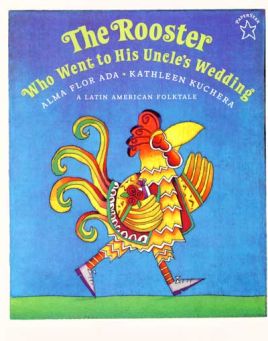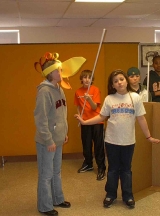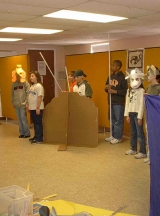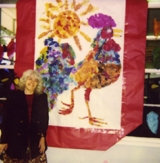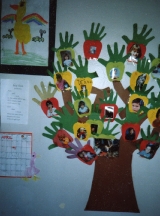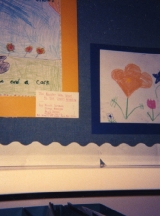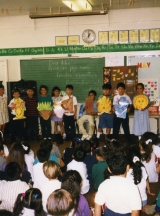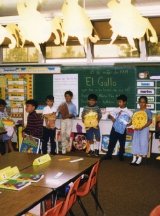The Rooster Who Went to His Uncle’s Wedding
El gallo que fue a la boda de su tío
A Latin American Folktale
RECOGNITIONS
One of the Best Books of the Year – Bank Street College
BOOK DESCRIPTION
What can you do if your beak is covered with mud, and the grass refuses to help you… the sheep won’t eat the grass… the dog won’t bite the sheep…? Well if you are a rooster on your way to your uncle’s wedding, you’ll ask your friend the sun, and he’ll surely turn things around! Outstanding illustrations by Kathleen Kuchera add brilliant tropical colors to this sunny story.
“Like the talented storyteller who shares her version with us now, this enchanting cummulative tale has roots in many Spanish-speaking countries around the world, where it has found a delighted audience of children.” (–Tomie de Paola)
AUTHOR’S NOTE
This is one of the many tales which I received from my Grandmother, my mother’s mother, who was a fabulous storyteller. She would tell it to me outdoors, usually on the porch, and would weave into the story any of the animals we could see –a goat, a cow—and the story would change from day to day, becoming as alive as our own surroundings. In turn, I have enjoyed telling this story to children and seeing them delight as I tell it faster and faster, as the list of characters grow. It has also been fun to see children perform this story as a play.
REVIEWS
Booklist
“This delightful cumulative tale introduces a perfectly groomed rooster with a gleaming beak, who’s on his way to his uncle’s wedding. As hunger overcomes him, he ponders, “Peck or not peck?” while looking at “a single golden kernel of corn” lying in a puddle of mud. Peck he does, and he muddies his beak as he gobbles the kernel down. Now, how to get his beak clean? The velvety grass won’t do it, but the rooster thinks perhaps he can scare the grass into helping, if he asks the lamb to eat the grass. The list of characters who refuse to help is long. Finally, the rooster’s good friend, the Sun, comes to his rescue. Each character, when threatened by a natural adversary, does what it is supposed to do, which in the end, helps the rooster. The rooster, a universal folk character humanized in many cultures, is appealing here. The story which was told to Ada by her grandmother in Cuba will delight young children with the sheer joy of its repetitive rhythms, and it is particularly appropriate to be told aloud. The illustrations, bright with tropical colors, depict a Latin American setting. The strongest element of this Latin American folktales is the universality of its theme, which makes it an interesting addition to the folktale collection for preschoolers.”
Publisher’s Weekly
The author of The Gold Coin retells a Latin American version of a familiar cumulative folk story illustrated in the vibrant colors of the tropics. In a narrative line reminiscent of Rosanne Littzinger’s The Old Woman and Her Pig, Ada tells of a rooster who muddles his beak en route to his uncle’s wedding feast; […] Through harmonious repetition and singsong rhythms, Ada’s leisurely, conversational tale neatly mimics the cadences of a Traditional storyteller. Kuchera’s (Your Skin and Mine) geometric illustrations in intense hues of orange and chartreuse evoke the designs of Latin American folk art with their flat edges, sharp lines, zigzags and whorls. […] The artist deserves kudos for her animated rendering of such normally static objects as a stick and a blade of grass.”
School Library Journal
Rooster, en route to his uncle’s wedding, struggles with the dilemma of whether he should risk of getting dirty in order to obtain a kernel of corn. His hunger overcomes his better judgment and, of course, he winds up “…with a beak full of mud.” This leads into a cumulative tale that will be familiar to anyone who knows “The Old Woman and Her Pig” or any number of its variants. In this case, his quest to get clean is nicely circular: the sun, just coming up as the book begins, is the one who agrees to break the chain of refusal, to repay the rooster for greeting him each morning. Ada’s lively adaptation uses economical language with just enough detail to move things along. Vivid hand-colored prints illustrate the story well. All of the characters are festively arrayed: the blades of grass, for example, play musical instruments, and one is wearing a gaucho hat and a cape. The sheep wears a ruffled dress and has a bowl of fruit on her head, a la Carmen Miranda. The plain white borders contribute to the clean pleasing design. The stylized patterns, with lots of diamonds and zigzags, have the look of Central and South American folk art. A solid addition to folklore collections and a story hour hit as well.
Kirkus Reviews
A cumulative tale that echoes “The Old Woman and Her Pig.” Since the debonair rooster is so busy preening his feathers and polishing his beak that he skips breakfast, the kernel of corn he finds on his way to the wedding is tempting, though it’s in a puddle. Seizing it, he muddies his shiny beak, and the trouble begins. The grass refuses to clean the beak; the dog won’t bite the lamb that won’t eat the grass–and so on, until the sun, grateful for the rooster’s daily song, starts to dry out the water, which starts to put out the fire…. This Latin American variant is gentler than the familiar tale, but just as lively. Kuchera’s decorative illustrations, with whimsical personifications (especially of the grass, fire, and water) and the elegantly stylized rooster in lemon, emerald, and flame against a brilliant blue sky, are splendid. An unusually appealing readaloud. (Folklore/Picture book. 3-8)
READERS’ RESPONSES
If you have enjoyed reading or sharing this book, I would very much like to hear from you. Please click here to send your comments.
